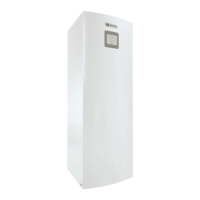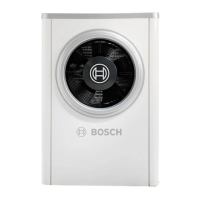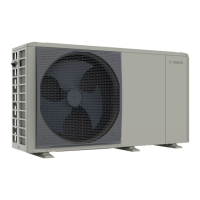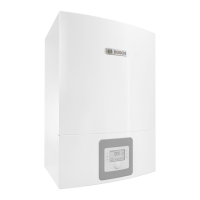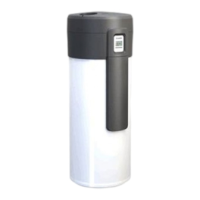Hydraulic connections
Compress 5800i AW – 6721858460 (2023/06)
16
▶ Turn off the underfloor heating circuits in damp areas (e.g. bathroom
and kitchen), and if necessary control via relay output PK2.
4.7.2 Mounting the condensation sensor
NOTICE
Material damage due to moisture!
If the system is operated below the dew point in cooling mode, this
causes moisture to precipitate on adjacent materials (floor).
▶ Do not operate underfloor heating systems in cooling mode below
the dew point.
▶ Set the correct flow temperature.
Condensation sensors are mounted on the pipes of the heating system
and send a signal to the control unit as soon as they detect condensate
formation. Installation instructions are enclosed with the sensors.
The control unit deactivates the cooling mode as soon as it receives a
signal from the condensation sensors. Condensate forms in cooling
mode when the temperature of the heating system is below the
corresponding dew point temperature.
The dew point will vary depending on temperature and humidity. The
higher the humidity, the higher flow temperature is required to remain
above dew point and avoid condensation.
4.7.3 Condensing cooling mode with fan convectors
It is mandatory to install a non-return valve to use the cooling mode (
see required accessories chapter in 2.8.1).
NOTICE
Material damage due to moisture!
Without full insulation against condensation, moisture can attack
neighbouring materials.
▶ Provide all pipes and connections up to the fan convector with
condensation insulation.
▶ Use an insulating material designed for cooling systems with
condensate formation.
▶ Connect condensate pipes to the drain.
▶ Do not use a condensation sensor when in cooling mode below the
dew point.
▶ Do not use a room temperature-dependent control unit with
integrated condensation sensor when in cooling mode below the dew
point.
When exclusively fan convectors with a drain and insulated pipes are
used, the flow temperature can be reduced to 7 °C.
NOTICE
Thermal breach!
When the cooling mode is used below dew point, the resulting
condensation may damage other components of the appliance.
▶ To avoid thermal breach, the installer should insulate the thermal
pipes (see Fig. 19 "Pipes that require insulation, when the
cooling mode is used below dew point").
Fig. 19 Pipes that require insulation, when the cooling mode is used
below dew point
5 Hydraulic connections
NOTICE
Residue in the pipework can damage the system.
Solids, metal/plastic filings, flux and thread tape residue and similar
material can get stuck in pumps, valves and heat exchangers.
▶ Keep foreign bodies from entering the pipework.
▶ Do not leave pipe parts and connections directly on the ground.
▶ When deburring, make sure that no residue remains in the pipe.
▶ Before connecting the heat pump and indoor unit, rinse the pipe
system to remove any foreign bodies.
5.1 Insulation
NOTICE
Material damage due to frost and UV radiation!
In case of a power outage the water in the pipes may freeze.
The insulation may become brittle due to UV radiation and crack after
some time.
▶ Use insulation with a thickness of at least 19 mm for pipework and
connections outdoors.
▶ Install drain valves so that the water can be drained out of the lines to
and from the heat pump if it is not going to be used for some time or
if there is a risk of frost.
▶ Use UV and moisture-resistant insulation.
▶ Insulate the wall insertion.
▶ In buildings, use insulation with a thickness of at least 12 mm for
pipework. This is also important for safe and efficient DHW mode.
0010049679-001

